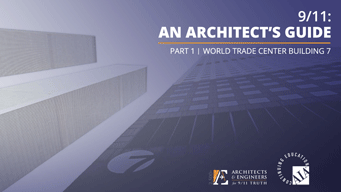Course Number: AE911-AAG-L1/2/3
1 LU/HSW for each part.
Live three-part webinar series. Each part is about one hour long, followed by a short Q&A.
Certificate of Completion: If you would like to request a certificate of the completion, please do so below at the end of the course.
Architects do not need to attend all three parts to earn learning units for the part(s) they attend.
AIA members: To register your attendance and earn learning units, please submit your name, email address, and AIA membership number online when you are asked to do so by the webinar instructor.
Upcoming Schedule
Part 1: Thursday, April 5, 2018 at 2PM Pacific
Part 2: Thursday, April 12, 2018 at 2PM Pacific
Part 3: Thursday, April 19, 2018 at 2PM Pacific
Course Description:
Never before has a steel-framed high-rise collapsed from fire. Why, then, did three such buildings collapse on September 11, 2001?
Part 1: World Trade Center Building 7
In Part 1 of “9/11: An Architect’s Guide,” Richard Gage, AIA, provides an overview of the most important evidence regarding the destruction of World Trade Center Building 7 (WTC 7), a 47-story high-rise that was not struck by an airplane.
The damage WTC 7 suffered from the collapse of the North Tower was found to be inconsequential. It had fires that were similar to those that have occurred previously in high-rise buildings. Yet it fell symmetrically into its own footprint in the manner of a typical controlled demolition.
In 2008, the National Institute of Standards and Technology (NIST) concluded that WTC 7’s destruction was caused by normal office fires that burned “at temperatures hundreds of degrees below those typically considered in design practice for establishing structural fire resistance ratings.”
Is NIST’s explanation for this unprecedented structural failure valid? Together, we will study the collapse and evaluate which of the two hypotheses — fire-induced failure or controlled demolition — is more consistent with the evidence. Participants will be encouraged to decide for themselves if a new investigation is warranted.
Part 2: Twin Towers’ Explosive Destruction
In Part 2 of “9/11: An Architect’s Guide,” Richard Gage, AIA, provides an overview of the most important evidence related to the explosiveness of the Twin Towers’ destruction. Much like that of WTC 7, the destruction of the Twin Towers exhibited most of the features of controlled demolition.
In 2005, the National Institute of Standards and Technology (NIST) concluded that the Twin Towers’ destruction resulted from the combined effects of the airplane impact damage and ensuing fires.
Is NIST’s explanation for these unprecedented structural failures valid? Together, we will study the collapses and evaluate which of the two hypotheses — fire-induced failure or controlled demolition — is more consistent with the evidence. Participants will be encouraged to decide for themselves if a new investigation is warranted.
Part 3: The Twin Towers And Extreme Heat
In Part 3 of “9/11: An Architect’s Guide,” Richard Gage, AIA, provides an overview of the most important evidence related to the extreme heat observed both before and after the Twin Towers’ destruction.
As documented extensively in the report issued by the National Institute of Standards and Technology (NIST), molten metal was seen pouring out of the South Tower during the seven minutes leading up to its collapse. Molten metal was also observed in the debris of both buildings, while various other evidence of extreme heat and incendiary chemical reactions have been documented since.
In 2005, NIST concluded that the Twin Towers’ destruction resulted from the combined effects of the airplane impact damage and ensuing fires, both of which are phenomena that fail to account for the extreme heat observed before and after the Twin Towers’ destruction.
Does NIST’s explanation for these unprecedented structural failures explain all of the evidence? Together, we will study the collapses and evaluate which of the two leading hypotheses — fire-induced failure or controlled demolition — is more consistent with the evidence. Participants will be encouraged to decide for themselves if a new investigation is warranted.
Learning Objectives:
Participants will be able to:
- Describe the characteristics of building fires and the aspects of high-rise design that contribute to make fire-induced failure in steel-framed high-rise buildings a rare occurrence.
- Recognize the distinct features associated with fire-induced failure and the distinct features associated with the procedure of controlled demolition.
- Describe step-by-step the series of structural failures that the National Institute of Standards and Technology found to be the most likely cause of the collapse of World Trade Center Twin Towers and Building 7.
- Analyze the physical evidence and the dynamics of the collapse of the Twin Towers and Building 7 according to how consistent they are with the competing hypotheses of fire-induced failure and controlled demolition.
Questions and Attendance
AIA members: Register your attendance during the presentation by submitting your name, email address, and AIA membership number below when you are asked to do so by the instructor. We will report your attendance to the AIA so that you will earn a learning unit for this course.
Take the Course
Part 1: World Trade Center Building 7
Please register your attendance using the 'Questions and Attendance' field above and complete the course evaluation below when the course is finished.
Part 2: The Twin Towers’ Explosive Destruction
Please register your attendance using the 'Questions and Attendance' field above and complete the course evaluation below when the course is finished.
Part 3: The Twin Towers and Extreme Heat
Please register your attendance using the 'Questions and Attendance' field above and complete the course evaluation below when the course is finished.
Course Evaluation
Call (510) 292-4710 or email This email address is being protected from spambots. You need JavaScript enabled to view it. if you have any questions.






